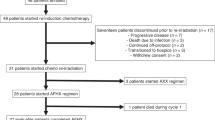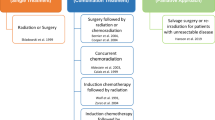Abstract
Despite recent advances in multimodality management of patients with stage III–IV head and neck squamous cell carcinoma, the prognosis in these patients remains disappointing. In an attempt to improve treatment outcome, several teams recently investigated the role of altered fractionation radiotherapy in conjunction with systemic chemotherapy. The controlled trials that investigated this combined approach indicate that, although the magnitude of its effect was less marked for survival indices than for local-regional control, the addition of chemotherapy to altered fractionation regimens results in a clear improvement for these endpoints compared with hyperfractionated or accelerated regimens alone. The key challenge now is to optimize the synergism of these regimens in order to increase their therapeutic ratio in terms of both local-regional and systemic outcomes. This review is a critical appraisal of the real opportunities offered by the application of treatments aimed at increasing the dose intensity of radiotherapy delivered concurrently with cytotoxic drugs.
This is a preview of subscription content, access via your institution
Access options
Subscribe to this journal
Receive 12 print issues and online access
$209.00 per year
only $17.42 per issue
Buy this article
- Purchase on Springer Link
- Instant access to full article PDF
Prices may be subject to local taxes which are calculated during checkout
Similar content being viewed by others
References
Parkin DM et al. (1992) Cancer incidence in five continents, vol. 6. Lyon: IARC
Bataini JP et al. (1988) Primary radiotherapy of squamous cell carcinoma of the oropharynx and pharyngolarynx: tentative multivariate modelling system to predict the radiocurability of neck nodes. Int J Radiat Oncol Biol Phys 14: 635–642
Hall EJ (1994) Radiobiology for the radiologist, edn 4. Philadelphia: Lippincott
Withers HR et al. (1988) The hazard of accelerated tumor clonogen repopulation during radiotherapy. Acta Oncol 27: 131–146
Horiot JC et al. (1992) Hyperfractionation versus conventional fractionation in oropharyngeal carcinoma: final analysis of a randomized trial of the EORTC cooperative group of radiotherapy. Radiother Oncol 25: 231–241
Dische S et al. (1997) A randomised multicentre trial of CHART versus conventional radiotherapy in head and neck cancer. Radiother Oncol 44: 123–136
Horiot JC et al. (1997) Accelerated fractionation (AF) compared to conventional fractionation (CF) improves locoregional control in the radiotherapy of advanced head and neck cancers: results of the EORTC 22851 randomized trial. Radiother Oncol 44: 111–121
Vermorken JB (1992) Adjuvant chemotherapy for advanced squamous cell carcinomas of the head and neck. In Multimodality therapy for head and neck cancer, 112–126 (Eds Snow GB and Clark JR) New York: Georg Thieme Verlag
Fu KK et al. (1987) Combined radiotherapy and chemotherapy with bleomycin and methotrexate for advanced inoperable head and neck cancer: update of a Northern California Oncology Group randomized trial. J Clin Oncol 5: 1410–1418
Harrison LD et al. (1991) Concomitant chemotherapy and radiation therapy for advanced unresectable head and neck cancer. Int J Radiat Oncol Biol Phys 21: 703–708
Herscher LL et al. (1999) Principles of chemoradiation: theoretical and practical considerations. Oncology 13 (10 Suppl 5): 11–22
Douple EB (1988) Platinum-radiation interactions. NCI Monogr 6: 315–319
Cooper JS and Ang KK (2005) Concomitant chemotherapy and radiation therapy certainly improves local control. Int J Radiat Oncol Biol Phys 61: 7–9
Vokes EE and Weichselbaum RR (1990) Radiotherapy with concomitant chemotherapy for head and neck cancer. J Clin Oncol 8: 911–934
Marcial VA et al. (1990) Concomitant cisplatin chemotherapy and radiotherapy in advanced mucosal squamous-cell carcinomas of the head and neck. Cancer 66: 1861–1868
Bernier J and Bentzen SM (2003) Altered fractionation and combined radio-chemotherapy approaches: pioneering new opportunities in head and neck oncology. Eur J Cancer 39: 560–571
Ang KK (1998) Altered fractionation trials in head and neck cancer. Semin Radiat Oncol 8: 230–236
Peters LJ et al. (1992) Altered fractionation schedules. In Principles and practice of radiation oncology, 2nd edn, 97–113 (Eds Perez CA and Brady LW) Philadelphia: J.B. Lippincott
Mendenhall WM et al. (2003) Altered fractionation and/or adjuvant chemotherapy in definitive irradiation of squamous cell carcinoma of the head and neck. Laryngoscope 113: 546–551
Bourhis et al. (2004) Meta-analysis of conventional versus altered fractionated radiotherapy: in head and neck squamous cell carcinomas (HNSCC): final analysis. 46th American Society of Therapeutic Radiology and Oncology (ASTRO) meeting, 3–7 October 2004, Atlanta. Int J Rad Oncol Biol Phys 60 (Suppl): S190–S191
Forastiere AA et al. (1992) Randomized comparison of cisplatin plus fluorouracil and carboplatin plus fluorouracil versus methotrexate in advanced squamous-cell carcinoma of the head and neck: A Southwest Oncology Group study. J Clin Oncol 10: 1245–1251
Jacobs C et al. (1992) A phase III randomized study comparing cisplatin and fluorouracil as single agents and in combination for advanced squamous cell carcinoma of the head and neck. J Clin Oncol 10: 257–263
Dewit L (1987) Combined treatment of radiation and cis-diamminedichloroplatinum (II): a review of experimental and clinical data. Int J Radiat Oncol Biol Phys 13: 403–426
Stell PM and Rawson NS (1990) Adjuvant chemotherapy in head and neck cancer. Br J Cancer 61: 779–787
Munro AJ (1995) An overview of randomised controlled trials of adjuvant chemotherapy in head and neck cancer. Br J Cancer 71: 83–91
El Sayed S and Nelson N (1996) Adjuvant and adjunctive chemotherapy in the management of squamous cell carcinoma of the head and neck region. A meta-analysis of prospective and randomized trials. J Clin Oncol 14: 838–847
Pignon JP et al. (2000) Chemotherapy added to locoregional treatment for head and neck squamous-cell carcinoma: three meta-analyses of updated individual data. MACH-NC Collaborative Group. Meta-Analysis of Chemotherapy on Head and Neck Cancer. Lancet 355: 949–955
Browman GP et al. (2001) Choosing a concomitant chemotherapy and radiotherapy regimen for squamous cell head and neck cancer: A systematic review of the published literature with subgroup analysis. Head Neck 23: 579–589
Bourhis J et al. on behalf of the MACH-NC Collaborative Group (2004). Update of MACH-NC (Meta-Analysis of Chemotherapy in Head & Neck Cancer) database focused on concomitant chemoradiotherapy. Proc Am Soc Clin Oncol 22 (Suppl): S5505
Wendt TG et al. (1998) Simultaneous radiochemotherapy versus radiotherapy alone in advanced head and neck cancer: a randomized multicenter study. J Clin Oncol 16: 1318–1324
Brizel DM et al. (1998) Hyperfractionated irradiation with or without concurrent chemotherapy for locally advanced head and neck cancer. N Engl J Med 338: 1798–1804
Dobrowsky W and Naude J (2000) Continuous hyperfractionated accelerated radiotherapy with/without mitomycin C in head and neck cancers. Radiother Oncol 57: 119–124
Jeremic B et al. (2000) Hyperfractionated radiation therapy with or without concurrent low-dose daily cisplatin in locally advanced squamous cell carcinoma of the head and neck: a prospective randomized trial. J Clin Oncol 18: 1458–1464
Staar S et al. (2001) Intensified hyperfractionated accelerated radiotherapy limits the additional benefit of simultaneous chemotherapy: Results of a multicentric randomized German trial in advanced head-and-neck cancer. Int J Radiat Oncol Biol Phys 50: 1161–1171
Huguenin P et al. (2004) Concomitant cisplatin significantly improves locoregional control in advanced head and neck cancers treated with hyperfractionated radiotherapy. J Clin Oncol 22: 4665–4673
Budach V et al. (2005) Hyperfractionated accelerated chemoradiation with concurrent fluorouracil-mitomycin is more effective than dose-escalated hyperfractionated accelerated radiation therapy alone in locally advanced head and neck cancer: final results of the radiotherapy cooperative clinical trials group of the German Cancer Society 95-06 Prospective Randomized Trial. J Clin Oncol 23: 1125–1135
Adelstein DJ et al. (2003) An Intergroup Phase III Comparison of Standard Radiation Therapy and Two Schedules of Concurrent Chemoradiotherapy in Patients With Unresectable Squamous Cell Head and Neck Cancer. J Clin Oncol 21: 92–98
Vokes EE et al. (2003) Weekly carboplatin and paclitaxel followed by concomitant paclitaxel, fluorouracil, and hydroxyurea chemoradiotherapy: Curative and organ-preserving therapy for advanced head and neck cancer. J Clin Oncol 21: 320–326
Rischin D et al. (2005) Tirapazamine, cisplatin, and radiation versus fluorouracil, cisplatin, and radiation in patients with locally advanced head and neck cancer: a randomized phase II trial of the Trans-Tasman Radiation Oncology Group (TROG 98.02). J Clin Oncol 23: 79–87
Bonner JA et al. (2004) ASCO 2004 Annual Meeting Proceedings 5507 (Suppl): S489
Chao KS et al. (2003) Toxicity profile of intensity-modulated radiation therapy for head and neck carcinoma and potential role of amifostine. Sem Oncol 30: 101–108
Lawrence TS et al. (2003) The Mechanism of action of radiosensitization of conventional chemotherapeutic agents. Semin Rad Oncol 13: 13–21
Author information
Authors and Affiliations
Corresponding author
Ethics declarations
Competing interests
The author declares no competing financial interests.
Glossary
- THERAPEUTIC RATIO
-
Defines the difference between a minimum therapeutically effective dose and a maximum dose capable of inducing intolerable side effects; the difference between the minimum and maximum effective doses; also known as therapeutic window
Rights and permissions
About this article
Cite this article
Bernier, J. Alteration of radiotherapy fractionation and concurrent chemotherapy: a new frontier in head and neck oncology?. Nat Rev Clin Oncol 2, 305–314 (2005). https://doi.org/10.1038/ncponc0201
Received:
Accepted:
Issue Date:
DOI: https://doi.org/10.1038/ncponc0201
This article is cited by
-
Combination therapy with radiation or cisplatin enhances the potency of Ad5/35 chimeric oncolytic adenovirus in a preclinical model of head and neck cancer
Cancer Gene Therapy (2009)
-
Strahlen-, Chemo- und Targettherapie von Kopf-Hals-Karzinomen
HNO (2009)
-
Results of selective neck dissection in the primary management of head and neck squamous cell carcinoma
European Archives of Oto-Rhino-Laryngology (2009)
-
Exploitable mechanisms for combining drugs with radiation: concepts, achievements and future directions
Nature Clinical Practice Oncology (2007)
-
Preventing or reducing late side effects of radiation therapy: radiobiology meets molecular pathology
Nature Reviews Cancer (2006)



